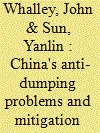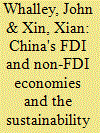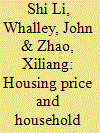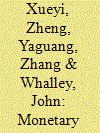|
|
|
Sort Order |
|
|
|
Items / Page
|
|
|
|
|
|
|
| Srl | Item |
| 1 |
ID:
119150


|
|
|
|
|
| Publication |
2013.
|
| Summary/Abstract |
This paper discusses China's relatively new structure of dual onshore and offshore RMB markets. Its distinguishing feature is both offshore trading at exchange rates that are market determined and onshore trading at exchange rates anchored at the official spot rate with capital account inconvertibility. We note that thus far the CNH and CNY spot rates have largely tracked each other, suggesting that the shadow price on the convertibility constraint onshore and also the offshore diversification benefit is close to zero. However, this could change in the future. We discuss the potential for the offshore RMB market to grow with trade settlement and bilateral swap arrangements in RMB, which would provide a big enough pool of liquidity for the RMB to become a vehicle currency and reserve currency. These potential developments will be restrained by onshore inconvertibility, but moving to convertibility seemingly implies major change in China's financial structure and the offshore RMB arrangements are only a small first step along this path. Crucial in this evolution of arrangements will be future Chinese growth performance and the relative attractiveness of onshore inconvertible but offshore marketable RMB relative to the debt laden and slow growth currencies of the USA, the EU and Japan.
|
|
|
|
|
|
|
|
|
|
|
|
|
|
|
|
| 2 |
ID:
148695


|
|
|
|
|
| Summary/Abstract |
The present paper explores the opportunities for China's regional trade agreement (RTA) initiatives to mitigate its anti-dumping problems. The paper highlights the severity and discriminatory nature of China's anti-dumping problems. The high concentration of the share of anti-dumping actions taken by the top 4 and top 8 anti-dumping initiators is noted. Our finding of a weak effect of existing RTAs on mitigating China's anti-dumping problems supports the argument that China could become more active in mitigating anti-dumping problems through RTA negotiations. An RTA can include a higher level of openness in exchange for an improvement in regional anti-dumping provisions. Case studies on RTAs involving the EU, the USA and India offer some precedents for offering inducements and modifying regional anti-dumping provisions. The approaches for China may lie in obtaining market economy status from intensive anti-dumping initiators at RTA levels and also altering regional anti-dumping provisions that could be put in place in exchange for some potential concessions.
|
|
|
|
|
|
|
|
|
|
|
|
|
|
|
|
| 3 |
ID:
093847


|
|
|
|
|
| Publication |
2010.
|
| Summary/Abstract |
This paper presents and assesses of the contribution of inward FDI to China's recent rapid economic growth using a two stage growth accounting approach. Recent econometric literature focuses on testing whether Chinese growth depends on inward FDI rather than measuring the contribution. Foreign Invested Enterprises (FIEs), often (but not exclusively) are joint ventures between foreign companies and Chinese enterprises, and can be thought of as forming a distinctive subpart of the Chinese economy. These enterprises account for over 50% of China's exports and 60% of China's imports. Their share in Chinese GDP has been over 20% in the last two years, but they employ only 3% of the workforce, since their average labor productivity exceeds that of Non-FIEs by around 9:1. Their production is more heavily for export rather than the domestic market because FIEs provide access to both distribution systems abroad and product design for export markets. Our decomposition results indicate that China's FIEs may have contributed over 40% of China's economic growth in 2003 and 2004, and without this inward FDI, China's overall GDP growth rate could have been around 3.4 percentage points lower. We suggest that the sustainability of both China' export and overall economic growth may be questionable if inward FDI plateaus in the future.
|
|
|
|
|
|
|
|
|
|
|
|
|
|
|
|
| 4 |
ID:
134890


|
|
|
|
|
| Summary/Abstract |
We document the sharp expansion of higher education in China beginning in 1999 and analyze its impacts on the unemployment of college graduates, using nationally representative population surveys from 2000 and 2005. We show that the expansion policy has increased the probability of college attendance among high school graduates. Using a difference-in-difference strategy, we find that China's expansion policy has sharply increased the unemployment rate among young college graduates, and that the unemployment rate for college graduates increases more in non-coastal (especially central) regions than in large coastal cities. We suggest that encouraging regional mobility of college graduates and increasing matching quality can potentially reduce the unemployment rate at the national level.
|
|
|
|
|
|
|
|
|
|
|
|
|
|
|
|
| 5 |
ID:
133183


|
|
|
|
|
| Publication |
2014.
|
| Summary/Abstract |
This paper decomposes the growth of China's export into three parts: growth in extensive margin, increased quantity and increased prices; we perform a series of empirical analyses using China's export data at the HS-6 digit level to analyze the characteristics of China's export growth. China's export growth depends more and more on price increases, less and less on quantity expansion. Compared with the rest of world, China's export price is in the process of improving, not at an increasing speed but at a declining pace. China's export performance is better than the rest of the world after the financial crisis and in 2008-2010. This reflects a strategy of lowering price and promoting sales in 2009 when facing a slump in export markets; and resuming price increases and increasing sales moderately in reaction to improving export conditions in 2010.
|
|
|
|
|
|
|
|
|
|
|
|
|
|
|
|
| 6 |
ID:
134880


|
|
|
|
|
| Summary/Abstract |
This paper utilizes a previously unavailable database on the commodity transactions of firms to analyze internal trade in China. This database is built from value-added tax (VAT) invoices collected under a comprehensive management information system, the Golden Tax Project (GTP). This project was established in 1994 to monitor and administer VAT collection and has been improved over the subsequent years. We present the structure, function, and evolution of the GTP, which provides reliable information on transaction values across provinces. We have access only to part of the GTP data set relevant to internal trade. The data suggests that internal trade in China has grown quickly but with seasonal fluctuations. Although the interprovincial trade in China is smaller than the interstate trade in United States and the intra-European Union trade, the high growth rate of the interprovincial trade suggests that economic connections among the provinces are strengthening. The positive relationship between internal trade and international trade in most regressions suggests the possible complementarity between these two types of trade.
|
|
|
|
|
|
|
|
|
|
|
|
|
|
|
|
| 7 |
ID:
121805


|
|
|
|
|
| Publication |
2013.
|
| Summary/Abstract |
This article investigates the effect of house prices on household savings rates in urban China employing the 2002 and 2007 data of the Chinese Households Income Project (CHIP). We find that the rapid appreciation of house prices cannot explain high Chinese households' savings rates and the rising of Chinese savings rates. On the contrary, we find a negative relationship between house prices and household savings rates for home renters and homeowners. We do not find any evidence of 'savings for housing purchase' for young home renters when house prices increase. Their savings rates declined during housing market booms in recent 10?years. Savings rates of homeowners possessing multiple housing have decreased more because of 'the pure housing wealth effects.'
|
|
|
|
|
|
|
|
|
|
|
|
|
|
|
|
| 8 |
ID:
123339


|
|
|
|
|
| Publication |
2013.
|
| Summary/Abstract |
In this paper, we discuss monetary thought in ancient China from the perspective of Western monetary theory. We set out the structure of economic activity in the various dynasties of ancient China and emphasize the differences in monetary structure from those of Europe and later North America. Imperial China was a politically integrated structure with regional segmentation of economic activities and hence with regional money. Monetary policy was conducted at the regional level but overseen politically. In various regions, different forms of money circulated, with gold, silver, copper, and paper money all presented at various times. Monetary policy was guided by monetary thought, as it was also guided later in Europe. Basic concepts, such as monetary functions, the velocity of circulation, inflation, interest rate parity and the quantity theory, were all present. The economics of Imperial China witnessed boom and bust, inflation and deflation and monetary control, similar to what was later seen in Europe. Chinese monetary thought thus seems to have preceded Western monetary thought and the two had remarkable similarities. Whether much of this thought traveled down the Silk Road remains unknown, but the possibility is intriguing.
|
|
|
|
|
|
|
|
|
|
|
|
|
|
|
|
| 9 |
ID:
112722


|
|
|
|
|
| Publication |
2012.
|
| Summary/Abstract |
This paper presents numerical simulation results that suggest that China can both reduce its trade imbalance and receive welfare benefits by switching the value added tax (VAT) regime from the current destination principle to an origin principle. We modify the traditional general equilibrium tax model to capture endogenous trade imbalances along with endogenous factor supply, a fixed exchange rate and a non-accommodative monetary policy structure which supports the Chinese trade imbalance. We calibrate model parameters to 2008 data and simulate counterfactual equilibrium for VAT tax basis switches in which the trade imbalance changes. Our results suggest that given China's trade surplus VAT regime switching to an origin basis can decrease China's trade surplus by over 40%, and additionally increase Chinese and world welfare. This has implications for present G20 discussions on finding ways to adjust global trade imbalances.
|
|
|
|
|
|
|
|
|
|
|
|
|
|
|
|
| 10 |
ID:
140235


|
|
|
|
|
| Summary/Abstract |
This study uses two different datasets to explore the stylized facts of interprovincial trade in China during the recent two decades. One dataset provides the magnitude of bilateral interprovincial goods trade calculated using firms' value-added tax invoices. The other supplies estimates of interprovincial trade using provincial input–output tables. We find that China has both a large value and a high growth rate of interprovincial trade, but there still exists a home bias in internal trade for most provinces. In addition, disaggregation by product shows that the manufacturing sector has the largest share of interprovincial trade and this share continues to grow. Finally, the spatial distribution of trade suggests that all provinces can be clustered into a smaller number of trade areas with large intra-cluster trade. Therefore, China's central government should make more effort to reduce local protection, stimulate domestic demand and coordinate interregional trade among local jurisdictions.
|
|
|
|
|
|
|
|
|
|
|
|
|
|
|
|
|
|
|
|
|